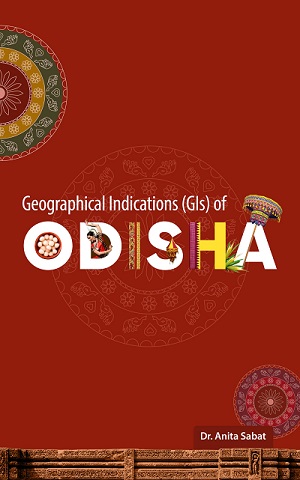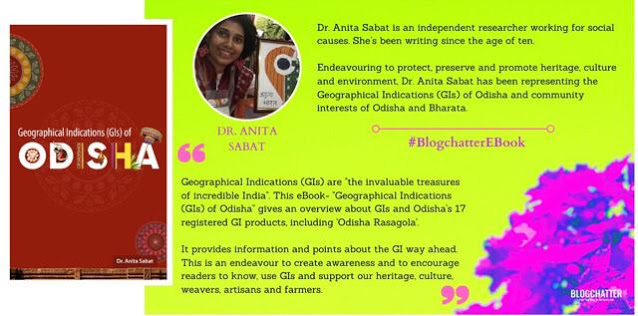
You say what is in a name?
Whether that spongy syrupy round sweet that you ate was r-a-s-a-g-o-l-a or r-o-s-o-g-o-l-l-a will depend upon where you ate it. It was not so until 29.07.2019 when ‘Odishara Rasagola’ got the GI tag to end the century long war between Odisha and West Bengal over the origin of Rasagola. In the forefront of that battle to get justice for Odishara Rasagola was Dr. Anita Sabat who is coincidentally the author of the book ‘GEOGRAPHICAL INDICATIONS (GIs) Of ODISHA’ that I have picked up for discussion in this post.
Now you may wonder what is this GI tag thing after all? If that is so, you are not alone even though chances are that you may be using products with GI tags regularly. I myself came to know about the existence of Geographical Indicator (GI) tags only after coming across Anita’s blog. So, who better to write a book about GI tags than Dr. Anita Sabat? By the way she has been a crusader for the protection and authentication of things connected with our culture and heritage both with her pen as well as with her field work.
After going through Anita’s book I learn that GI Tags are elements of Intellectual Property Rights in the context of products that are associated with a particular locality. If IPRs are attributed to particular individuals or legal entities, GI tags are attributable to the tradition of a locality.
We are familiar with products being associated with a locality. Products like Banarasi Pata, Kanchipuram Silk, Agra Petha etc. are distinguished by their association with a particular locality. It is difficult to find out which individual invented it. These product got refined by the collaborative efforts of the artisans of that locality over a period of time, sometimes stretching over centuries or millennia. Like Intellectual property Rights, products developed in a locality too need legal protection. Of course mere legal protection is not enough. The public need to be aware of this aspect. This is where Anita’s book on GI Tags fills the gap.
“A Geographical Indication (GI) is an agricultural, natural or a manufactured product (handicrafts, food stuff, and industrial goods) originating from a definite geographical territory”.
Odisha has got 17 GI tags registered so far. In this book the author discusses in detail about each of those products. In addition to Odishara Rasagola, some of the popular GI tag products are Pipli Applique work, Orissa Pattachitra, Sambalpuri Bandha Sari. There are many products which are associated with my native district which surprisingly I did not know earlier. E.g. Ganjam Kewda Flower and Ganjam Kewda Rooh.
You may come across many of such products in different exhibitions. But chances are that some of them could be fake. Here some knowledge about the specialty of that product can help one distinguish the fake from the original ones. This book on GI tags can help as a ready reference in such matters.
Products with GI tags are not usually machine made. Lots of skill and labour go into making such products. Thus it is fair that use of products with GI tags should be popularised and people should also be careful about fake products.
The book also explains why some GI products bear the name like Orissa Pattachitra even though the name of the spelling of the state has been changed to Odisha since 2011. The book also includes information and photos good photos of events associated with the products. The book is not a dry manual for GI tags of Odisha. It is full of tit bits about the history and other associations of the products.
I whole heatedly agree with the view of the author that Geographical Indications can be a major engine of economic growth & can contribute significantly in terms of GDP, foreign exchange earnings and employment. It is heartening to note that in spite of having such rich heritage India has fewer registered GIs as compared to some other nations. When more people are aware of such products and more products get registered, I am sure artisans, weavers & farmers will get a wider platform to get their due.
It is a book which must be read by every one who loves the traditional art, costumes, cuisine and other products of India. Dr. Anita Sabat has written this book out of her first hand knowledge. She has been actively involved for getting GI tags registered for many local products. Even though only the products of Odisha are included in this book, it goes without saying that most of these products are popular outside Odisha.
This book may also be an inspiration for the culture and heritage lovers to be aware of the products of their locality that deserve GI tags. In case it is found that some deserving products do not have GI tags, they can take inspiration from the author and launch a crusade to get those products registered. By the way, the book also contains detailed information about what are GI tags and how to register a product to get the tag.

As part of blogchatter ebook carnival the book is available for free download. Get your copy to know more about GI tags and our unique cultural heritage.
My book, ‘My Village My Country’, is now available on Amazon.
Thank you so much for your incisive & great review.
In your lucid words, you have touched the key points & helped share the info & importance of GI.
Not many of us are aware about GIs & even the GI products of our state… May more learn, use & support GI producer groups & products.
Thank you for spreading this message further. 🙏🏻
Awareness is much needed.
LikeLiked by 1 person
Your effort to create awareness about our culture and heritage deserve kudos.
LikeLike
Keenly analysed and very apt review! Surely it is a must read by all.
LikeLiked by 1 person
Thank you.
LikeLiked by 1 person
Beautiful review for a beautiful book. Indeed a treasure to read especially for people like us who hail from the land and yet are unaware of it fully.
LikeLiked by 1 person
Indeed the book is an eye opener.
LikeLike
A very interesting area of conversation Durga Prasad, I suppose a key difference is that with intellectual property rights the royalty is paid to a business etc whereas with GI it is local and generally a lesser profit measure I presume. I maybe wrong but I do feel a sense of protection to smaller business which is great as opposed to bisinesses turning profit on ipr
LikeLiked by 1 person
IPR constitutes patent, trademark, copyright & GI too. GI is a community right. The producer group gets the GI certificate for their unique and special products. A long process is involved.
LikeLiked by 1 person
I think the question of royalty may not arise in the case of products with GI tags because products of a geographical locality are usually not allowed to be produced by any other region, where as products with IPR are allowed to be produced by others provided they pay royalty. GI tag is more of a protective accreditation and it prevents indiscriminate use of the name for fake products.
LikeLike
Nice analysis. BTW, what’s in a GI tag? Rasogolla from Bengal or Odisha both are as sweet.
LikeLiked by 1 person
Thank you for stopping by. I think there are subtle differences in the taste of the sweet. GI tag brings out these subtle differences. Banglar Rosogola too has its GI tag.
LikeLiked by 1 person
Yes, true. I meant to say that if you try to find the difference, howsoever subtle it may be, you won’t relish the Rosogolla. But, yes historical and geographical credits must be given.
LikeLike
A detailed and insightful review, sir… I loved this as much as I loved reading the book 🙂
LikeLiked by 1 person
Happy that you both liked the book and the review. Thanks for stopping by.
LikeLike